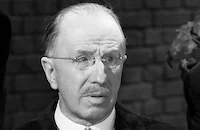The Grim Game

Brief Synopsis
Cast & Crew
Irvin Willat
Harry Houdini
Thomas Jefferson
Ann Forrest
Augustus Phillips
Tully Marshall
Film Details
Technical Specs

Synopsis
Young newspaper reporter Harvey Hanford is in love with Mary Cameron, the ward of his rich, eccentric Uncle Cameron, who opposes the match. Harvey agrees to a newspaper scheme to plant evidence for a fake murder of his uncle, implicating himself, in order to argue against circumstantial evidence. The uncle is actually killed, however, and Harvey is arrested for the murder. Harvey then has a series of remarkable escapes from handcuffs, chains and a straightjacket, culminating in a mid-air airplane collision. Finally, Harvey is vindicated and reunited with Mary.

Director
Irvin Willat
Cast
Harry Houdini
Thomas Jefferson
Ann Forrest
Augustus Phillips

Tully Marshall

Arthur Hoyt

Mae Busch
Ed. Martin
Jane Wolf
Crew

Photo Collections
Videos
Movie Clip



Hosted Intro
Film Details
Technical Specs

Articles
The Grim Game

The Grim Game
Houdini: The Movie Star - HOUDINI: THE MOVIE STAR - New 3-Disc Set from Kino International
The films' escapes have an extra layer of textual gist to them in real life, Houdini's performances, whether on a theater stage or hanging upside-down over a city street in a strait-jacket, were merely daring showbiz acts, to sell tickets and/or drum up publicity. They had no independent meaning, separate from the public's rubber-necking affection for them and the money they made Houdini and his backers. But Houdini's movies do cartwheels and handstands fabricating dramatic contexts for these same escapes, so they are unavoidable cornerstones in elaborate plots in which Houdini's characters (always bearing double-H initials) are haplessly embroiled. The films substantiate the escapes as "real" crises and heroisms, thereby allowing Houdini, and his viewers, to daydream together about a pulp world in which Houdini's redoubtale skills would be of real use, to fight real villains and save real lives, instead of being merely pointless public entertainment. Movies being what they are, audiences between 1919 and 1923 went to Houdini's movies for the sheer spectacle of seeing Houdini be Houdini, but they also got lost in a fantasy landscape where Houdini wasn't a magician but an invincible ubermensch, fighting evil.
It could only happen in Hollywood a 5'5" Jewish kid from Hungary becomes, by virtue of his own bravado and double-jointed-ness, a kind of aboriginal superhero. In the years leading up to 1919, Douglas Fairbanks was honing his vibrant brand of nervy physical jouissance, but the Sax Rohmer-influenced mix in the Houdini movies of evil conspiracies, relentless stunt-man peril and outrageous invention (The Master Mystery features cinema's first, and probably most hilarious, robot) formed the template for scores of action-adventure serials to come, through to the decades leading up to television, and then including Alfred Hitchcock's most popular wrong-man thrillers, countless psychotronic TV shows, and the Indiana Jones movies as well as the uncountable imitators of all of the above. This is the ground floor in a vast cultural enterprise, a bottomless geyser of silly all-American thrill-making. (The exception may be 1922's The Man from Beyond, which recounts how a man, frozen on an Arctic shipwreck for a century, is thawed and awakens to obsessions about the woman he left behind. Produced by Houdini's own company, it awaits a remake.)
For all of the reality-fantasy slippage sensed in the films' use of Houdini's persona, he was far from an inadequate leading man. Acting in serials was not rocket science, but by virtue of his small frame's athletic confidence and quicksilver reflexes Houdini was as hypnotic a physical presence as Fairbanks or Buster Keaton, whether it be writhing out of chains or matter-of-factly grabbing and lifting up bigger men over his head with one motion. Never does the lizard-eyed Houdini seem awkward or out of place or anything less than commanding, even given his bizarre schoolboy haircut and effulgence of mascara.
But perhaps the final and decisive allure of the DVD set, presenting in toto a fascinating episode in American cinema history most of us knew absolutely nothing about, comes down to its breathless, blissful aura of old-fashioned odeon naivete. Like many forgotten and unhailed silent films, Houdini's evoke a lovely, child-like revisitation to a ghostly past we'd long since ceased to remember as significant. The movies' stylistic, thematic and narrative material becomes secondary to the weight of history film history as well as cultural history. You could learn acres about the American sensibility just after the Great War from these films, but in the meantime watching them is like an itch-free morphine dream from which you don't long to wake.
For more information about Houdini: The Movie Star, visit Kino International. To order Houdini: The Movie Star, go to TCM Shopping.
by Michael Atkinson
Houdini: The Movie Star - HOUDINI: THE MOVIE STAR - New 3-Disc Set from Kino International
Quotes
Trivia
The mid-air collision was accidental; the story was revised to incorporate it.
Notes
Scripts in Paramount studio records disagree with contemporary reviewers in giving the character names of Mary Wentworth instead of Mary Cameron, David Allison instead of Clifton Allison, and Nick Raver instead of Richard Raver. Publicity for the film centered on an accidental plane crash that was recorded on film and necessitated a change of endings. Jane Wolf is probably the same as the actress Jane Wolfe.















